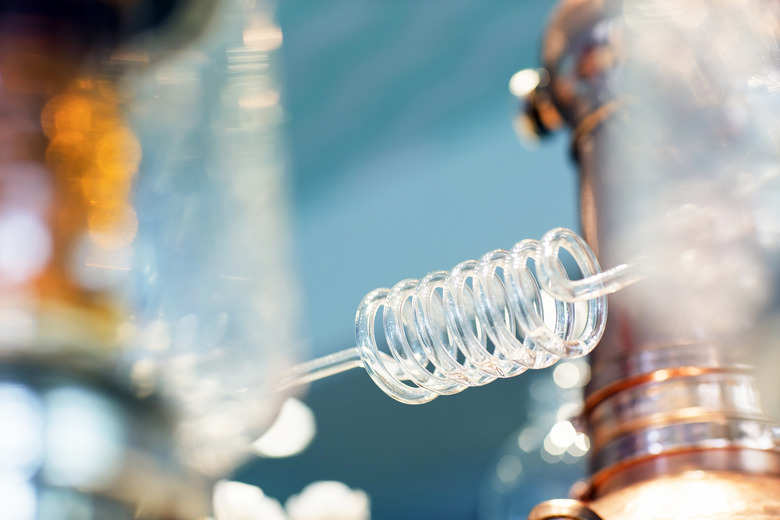Three Examples Of Simple Distillation Mixtures
Not all liquids have the same boiling point. Sometimes, chemists are able to use those different volatility points in order to separate liquids during a process called distillation. You may have seen the process in action if you ever visited a distillery where alcoholic beverages are made, but there are also several other types of simple distillation mixtures used in everyday life.
TL;DR (Too Long; Didn't Read)
Simple distillation is used to separate salt from seawater, to separate sugar from water and to separate ethanol from water in the production of hard liquor.
Simple Distillation
Simple Distillation
Simple distillation happens through a process of heating and cooling liquids in order to separate and purify them. First, a liquid is heated, producing a vapor. Then, that vapor is cooled in a small tube called a condenser, in order to form a separate liquid. That separate liquid, sometimes referred to as the distillate, falls from the condenser into a separate container. The process works because the two liquids in the original liquid vaporize at different points, meaning the vapor that is created is comprised entirely of just one of the liquids. In order for simple distillation to work, the two liquids' boiling points must have a difference of at least 25 degrees Celsius, or about 77 degrees Fahrenheit.
Water Distillation
Water Distillation
One example of a simple distillation mixture is separating saltwater to create pure water and salt. During the distillation process, the water starts to evaporate, and that vapor then cools down to form pure water. The pure water is collected in a second container. Once the distillation process has completed, salt is left behind in the original container that previously held the saltwater.
This is a process used around the world when people want to extract pure water from seawater since salty seawater is unsafe for humans to consume. Unlike the process of evaporation, which results in some pure water with more saltwater left behind, distillation completely separates the two materials. Simple distillation does use large amounts of energy, though, so a more popular method of separating saltwater is through desalination. But the process of distillation is also used in some cases.
A second example of a simple distillation mixture involving water is the separation of a sugar water blend. Since sugar and water have different boiling points, the water will begin to evaporate first, and then cool to turn into pure water. Sugar will be left behind in the original container.
Ethanol & Water
Ethanol & Water
A third example of simple distillation, and perhaps the most well known, is the separation of ethanol from water. This is the process used to create hard liquors. Fermented grains, such as wine, often have an alcohol percentage in the teens, but the fermentation process can't produce much alcohol percentages higher than that. Harder liquors such as rum, gin and whiskey often contain as much as 40% alcohol or more. In order to get that higher percentage, alcoholic beverage makers start with a fermented alcohol mixture, and then distill it.
Alcohol has a lower boiling point than water, so when a mixture like wine is heated, the alcohol begins to evaporate before the water. It cools and then condenses back into a liquid. Because that liquid is more dense than the original fermented mixture, the alcohol percentage in that mixture is higher.
Cite This Article
MLA
Dragani, Rachelle. "Three Examples Of Simple Distillation Mixtures" sciencing.com, https://www.sciencing.com/three-examples-simple-distillation-mixtures-7172380/. 17 May 2018.
APA
Dragani, Rachelle. (2018, May 17). Three Examples Of Simple Distillation Mixtures. sciencing.com. Retrieved from https://www.sciencing.com/three-examples-simple-distillation-mixtures-7172380/
Chicago
Dragani, Rachelle. Three Examples Of Simple Distillation Mixtures last modified March 24, 2022. https://www.sciencing.com/three-examples-simple-distillation-mixtures-7172380/
